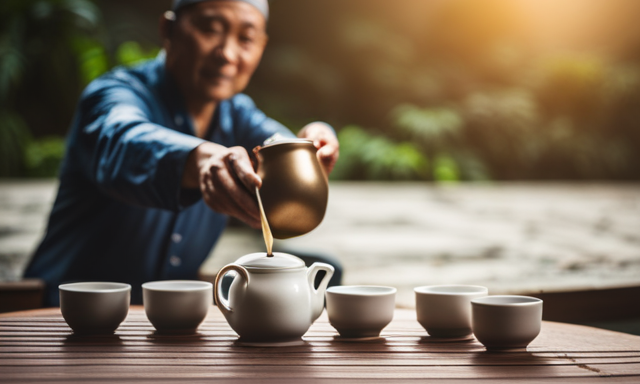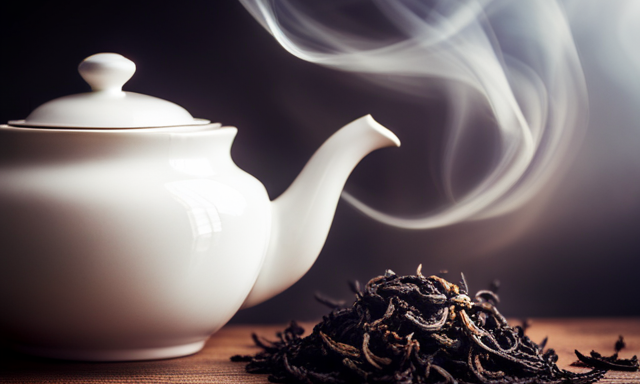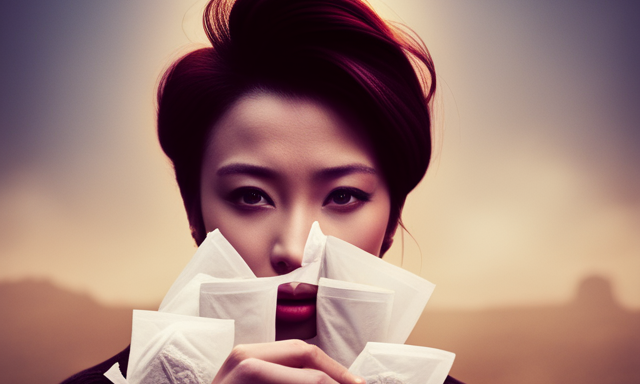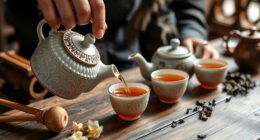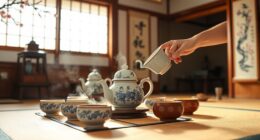Coincidentally, I recently discovered the wonders of Wuyi Oolong tea, and let me tell you, it is truly something special.
As I delved into the world of tea, I couldn’t help but be captivated by the rich history and unique flavor profile of this particular variety.
Wuyi Oolong tea originates from the stunning Wuyi Mountains in China, where the tea leaves are meticulously grown and processed with utmost care. The result is a tea that boasts a complex and enticing taste, with notes of roasted nuts, caramel, and a subtle floral undertone.
Not only does Wuyi Oolong tea offer a delightful sensory experience, but it also provides numerous health benefits, from boosting metabolism to promoting heart health.
Its cultural significance in China cannot be overstated, and its influence on other teas is undeniable.
If you’re looking to explore the world of tea, I highly recommend diving into the realm of Wuyi Oolong tea.
Key Takeaways
- Wuyi Oolong Tea is grown in the Wuyi Mountains in China and has a long history of cultivation.
- It has a unique flavor profile with smoky and floral notes, and a rich and complex taste.
- Wuyi Oolong Tea offers numerous health benefits, including boosting metabolism, providing antioxidants, and promoting overall well-being.
- The cultural significance of Wuyi Oolong Tea is deeply intertwined with Chinese culture, influencing other teas, and being enjoyed during special occasions and rituals.
The Origins of Wuyi Oolong Tea
The origins of Wuyi Oolong tea can transport you back in time to the ancient and mysterious cliffs of the Wuyi Mountains. This exceptional tea holds great historical significance, as it has been cultivated and enjoyed for centuries.
The unique terroir of the Wuyi Mountains, with its rocky and mineral-rich soil, imparts a distinctive flavor to the tea. The leaves are carefully hand-picked and then undergo a meticulous processing method that includes withering, rolling, and roasting. This intricate process brings out the complex flavors and aromas that make Wuyi Oolong tea so revered.
The result is a tea with a rich, robust taste and a captivating aroma. As we delve into the next section, we will explore the unique flavor profile of Wuyi Oolong tea.
The Unique Flavor Profile of Wuyi Oolong Tea
Surprisingly, this particular brew has a taste that can only be described as a delightful combination of smoky and floral notes. The flavor profile of Wuyi Oolong tea is truly unique and has captivated tea enthusiasts for centuries.
When brewed correctly, this tea offers a rich and complex taste that is both comforting and invigorating. The smoky notes bring a sense of depth and warmth, while the floral undertones add a touch of elegance and sweetness. It is truly a harmonious blend of flavors that dance on the palate.
To bring out the best in this tea, it is important to use the right brewing techniques. The water temperature should be around 195°F, and the leaves should be steeped for about 3-4 minutes. This allows the flavors to fully develop and creates a truly exceptional cup of tea.
Now, let’s explore the health benefits of Wuyi Oolong tea.
The Health Benefits of Wuyi Oolong Tea
The unique flavor profile of Wuyi Oolong tea is not the only reason to indulge in this delicious beverage. Wuyi Oolong tea also offers numerous health benefits that make it a worthwhile addition to your daily routine.
One of the main benefits is its potential to aid in weight loss. Wuyi Oolong tea has been shown to boost metabolism and increase fat burning, making it a natural ally for those looking to shed a few pounds.
Additionally, Wuyi Oolong tea is packed with antioxidants, which can help protect against cell damage and reduce the risk of chronic diseases. These properties make it a powerful weapon in promoting overall health and well-being.
Transitioning into the next section about the art of growing Wuyi Oolong tea in the Wuyi Mountains, this tea’s health benefits are just the beginning of its remarkable story.
The Art of Growing Wuyi Oolong Tea in the Wuyi Mountains
Explore the enchanting world of Wuyi Oolong tea as it flourishes in the breathtaking landscapes of the Wuyi Mountains, where every leaf is nurtured with utmost care and craftsmanship.
The cultivation techniques used in growing Wuyi Oolong tea are truly an art form. The tea plants are meticulously tended to, with each step in the process carefully executed to ensure the highest quality leaves.
The unique climate of the Wuyi Mountains plays a crucial role in the flavor profile of this tea. The misty mornings, warm days, and cool nights create the perfect conditions for the tea leaves to develop their distinct flavors and aromas. The combination of the mountainous terrain and the mineral-rich soil further enhances the complexity of the tea.
As we dive deeper into the world of Wuyi Oolong tea, let’s explore the different varieties that this region has to offer.
The Different Varieties of Wuyi Oolong Tea
When it comes to the different varieties of Wuyi Oolong Tea, three key points stand out:
- Da Hong Pao (Big Red Robe): Known for its rich and complex flavor profile.
- Shui Jin Gui (Golden Water Turtle): Offers a unique combination of floral and fruity notes.
- Rou Gui (Cinnamon): Prized for its distinctive cinnamon aroma and warm, spicy taste.
Each variety brings its own unique characteristics to the world of Wuyi Oolong Tea, making it a truly diverse and fascinating beverage.
Da Hong Pao (Big Red Robe)
Try experiencing the rich and aromatic Da Hong Pao oolong tea, known as the Big Red Robe, to indulge your taste buds in its unique flavors.
-
Da Hong Pao cultivation:
Grown in the Wuyi Mountains, a UNESCO World Heritage site in China.
Only a few tea bushes left, making it rare and highly sought after.
Grown on rocky cliffs, absorbing minerals that give it a distinct taste. -
Da Hong Pao flavor profile:
Roasted and earthy with hints of charcoal and chocolate.
Smooth and full-bodied, leaving a lingering sweet aftertaste.
A complex blend of flavors that evolves with each sip.
Da Hong Pao is just the beginning of the remarkable journey through the world of Wuyi oolong teas. Next, let’s dive into the captivating flavors of shui jin gui (golden water turtle).
Shui Jin Gui (Golden Water Turtle)
Shui Jin Gui, also known as Golden Water Turtle, is a rare and sought-after variety of tea grown in the Wuyi Mountains. Only a limited number of tea bushes remain, making it highly prized by tea enthusiasts. The tea gets its name from its unique golden color and the shape of its leaves, which resemble a turtle’s shell.
Tea farming techniques for Shui Jin Gui require careful attention to detail. Farmers must ensure proper soil and climate conditions, as well as employ organic cultivation methods. The traditional processing methods for this tea involve withering, rolling, roasting, and fermenting the leaves. These steps bring out the tea’s distinctive flavors and aromas.
Shui Jin Gui has earned numerous accolades in tea competitions and awards, further enhancing its reputation. It is deeply intertwined with cultural rituals and ceremonies, often enjoyed during special occasions or as a form of hospitality. Health studies and research have shown potential benefits of Shui Jin Gui, including improved digestion and antioxidant properties.
Tea tourism and travel experiences offer opportunities to explore the Wuyi Mountains and witness the tea-making process firsthand. Tea accessories and brewing tools, such as clay teapots and bamboo tea trays, are commonly used to enhance the tea-drinking experience.
Transitioning to the subsequent section about ‘rou gui (cinnamon)’, this aromatic tea variety shares similar cultivation and processing techniques with Shui Jin Gui.
Rou Gui (Cinnamon)
Now that we have explored the fascinating Shui Jin Gui oolong tea, let’s dive into the world of Rou Gui, also known as Cinnamon oolong tea.
This particular variety of Wuyi oolong is renowned for its warm and inviting aroma, reminiscent of freshly baked cinnamon rolls. Not only does it tantalize the senses, but Rou Gui also offers a plethora of health benefits.
Cinnamon is known for its anti-inflammatory properties and ability to regulate blood sugar levels. It can even aid in digestion and boost the immune system.
To reap the benefits of this delightful tea, one can try various cinnamon tea recipes, such as adding a sprinkle of cinnamon powder or a cinnamon stick to hot water.
Now, let’s move on to the traditional preparation and brewing of Wuyi oolong tea, where we will discover the artistry behind this ancient beverage.
The Traditional Preparation and Brewing of Wuyi Oolong Tea
Experience the rich aroma and deep flavors of Wuyi Oolong tea as you savor the traditional brewing process that has been passed down for generations. To truly appreciate this exquisite tea, it is essential to follow the time-tested steps of preparation. Here is a step-by-step guide to brewing Wuyi Oolong tea, capturing its essence in every sip:
| Step | Description |
|---|---|
| 1 | Preheat your teapot and cups by rinsing them with hot water. |
| 2 | Place the tea leaves into the teapot, using approximately 1 teaspoon per cup of water. |
| 3 | Pour hot water over the tea leaves and let them steep for about 30 seconds. |
| 4 | Slowly pour the tea into the cups, allowing it to flow freely and evenly. |
| 5 | Take a moment to appreciate the color, aroma, and clarity of the tea. |
| 6 | Savor the tea slowly, enjoying its rich, complex flavors. |
Through this traditional brewing process, the true character of Wuyi Oolong tea is revealed. It showcases the craftsmanship and dedication that has made this tea a cultural symbol in China. The cultural significance of Wuyi Oolong tea in China goes beyond its taste. It is deeply rooted in history, tradition, and the art of tea-making.
The Cultural Significance of Wuyi Oolong Tea in China
When it comes to discussing the cultural significance of Wuyi Oolong tea in China, three key points come to mind: the tea ceremony and etiquette, historical and literary references, and tea as a symbol of hospitality.
The tea ceremony and etiquette surrounding Wuyi Oolong tea are deeply ingrained in Chinese culture. Specific rituals and traditions dictate the proper way to prepare and serve the tea. These customs reflect the importance of mindfulness, respect, and harmony in Chinese society.
Wuyi Oolong tea has also been referenced in historical and literary works, highlighting its importance and value throughout history. Poems and stories often mention the tea’s exquisite flavor and aroma, elevating it to a symbol of refinement and sophistication.
Lastly, Wuyi Oolong tea is seen as a symbol of hospitality. It is commonly served to guests as a gesture of respect, warmth, and friendship. Offering this tea to visitors is a way to create a welcoming and comfortable atmosphere.
Overall, the cultural significance of Wuyi Oolong tea in China is multifaceted. It encompasses the tea ceremony and etiquette, historical and literary references, and the tea’s role as a symbol of hospitality. These aspects demonstrate the deep-rooted appreciation and value that Chinese culture places on this unique and cherished tea.
Tea Ceremony and Etiquette
As you partake in the ancient art of sipping Wuyi oolong tea, be sure to follow the intricate tea ceremony and etiquette. The tea ceremony is a time-honored tradition that dates back centuries in China. It is a ritualistic practice that requires patience, precision, and respect. Here are three key elements of the tea ceremony and etiquette:
-
Preparation: Before serving the tea, it is important to cleanse and warm the teapot and cups. This ensures that the tea is brewed at the optimal temperature and the flavors are fully extracted.
-
Serving: The tea should be poured slowly and gracefully, with the host offering the first cup to the guest as a sign of respect. It is customary to hold the cup with both hands and take small sips.
-
Appreciation: While savoring the tea, it is essential to show appreciation and gratitude to the host. This can be done through polite conversation, compliments on the tea, and expressing gratitude for the experience.
By following these tea ceremony rituals and etiquette, you can truly immerse yourself in the rich cultural heritage of Wuyi oolong tea. Now, let’s delve into the historical and literary references that have made this tea so revered.
Historical and Literary References
Immerse yourself in the historical and literary references surrounding the revered Wuyi oolong tea, gaining a deeper understanding of its significance in Chinese culture.
Wuyi oolong tea has a rich historical significance, as it has been cultivated in the Wuyi Mountains for centuries. It was first mentioned in writings dating back to the Ming Dynasty, where it was praised for its unique flavor and health benefits.
The tea’s popularity grew even further during the Qing Dynasty, when it became a tribute tea offered to emperors. In literature, Wuyi oolong tea is often portrayed as a symbol of refinement and sophistication. It is frequently mentioned in classical works of poetry and prose, highlighting its cultural importance.
As we explore further, we will discover how this tea also serves as a symbol of hospitality in Chinese society.
Tea as a Symbol of Hospitality
Tea graciously welcomes guests into Chinese homes, symbolizing hospitality and warmth. It is an integral part of the Chinese way of life, with tea ceremonies being a common practice to honor guests and create a sense of harmony.
Beyond its cultural significance, tea offers numerous health benefits. It is rich in antioxidants, helping to boost the immune system and promote overall well-being. Regular consumption of tea has been linked to improved heart health, increased metabolism, and enhanced mental alertness.
As we delve into the world of wuyi oolong tea and its influence on other teas, let us uncover the secrets behind its unique flavor and aroma.
Wuyi Oolong Tea and its Influence on Other Teas
Wuyi Oolong Tea has had a significant influence on other teas, such as Tie Guan Yin (Iron Goddess of Mercy), Rock Tea, and Dan Cong Tea.
Tie Guan Yin is known for its delicate floral aroma and smooth taste, while Rock Tea is characterized by its rich and robust flavor.
Dan Cong Tea stands out with its unique and varied flavors, ranging from fruity to floral.
These teas have gained international popularity and recognition for their exceptional quality and distinct characteristics.
Tie Guan Yin (Iron Goddess of Mercy)
Discover the smooth and delightful taste of Tie Guan Yin, the famous Iron Goddess of Mercy oolong tea that will captivate your senses.
This exquisite tea is cultivated using traditional tie guan yin farming techniques, which involve meticulous care and attention to detail. The tea leaves are carefully picked and processed to bring out the unique flavors and aromas that make Tie Guan Yin so special.
In addition to its exceptional taste, Tie Guan Yin also holds a significant place in Chinese tea culture. It is often served in a traditional tie guan yin tea ceremony, where the tea is brewed and enjoyed in a ceremonial manner. This tea is a true testament to the artistry and craftsmanship that goes into producing such a fine beverage.
Moving on to rock tea and dan cong tea, these varieties offer their own distinct flavors and characteristics.
Rock Tea and Dan Cong Tea
After exploring the intricacies of Tie Guan Yin, it’s time to delve into the fascinating world of Rock Tea and Dan Cong Tea.
Rock tea, also known as Yancha, is cultivated in the rocky cliffs of the Wuyi Mountains. The unique terroir and mineral-rich soil of this region contribute to the distinct flavor profile of Rock Tea, characterized by its bold and robust taste.
On the other hand, Dan Cong Tea is renowned for its diverse range of flavors, with each variety resembling the taste of different fruits, flowers, or spices. Not only does Dan Cong Tea offer a delightful sensory experience, but it also boasts numerous health benefits, including improved digestion and enhanced mental focus.
As we move forward, let’s explore the international popularity and recognition that Wuyi Oolong Tea has gained over the years.
International Popularity and Recognition
The widespread acclaim and global recognition that this unique and flavorful tea has earned over the years is truly remarkable. Its international popularity can be attributed to strategic marketing efforts that have successfully introduced Wuyi Oolong tea to tea lovers around the world.
This tea’s cultural significance extends beyond its country of origin, as it has become a symbol of Chinese tea culture in many other countries as well. The distinct aroma and rich taste of Wuyi Oolong tea have captivated tea enthusiasts worldwide, making it a sought-after beverage.
Many tea connoisseurs appreciate its complexity and the range of flavors it offers, from fruity to floral to roasted. Additionally, its health benefits, including improving digestion and boosting metabolism, have further contributed to its popularity.
Now, let’s explore where to buy authentic Wuyi Oolong tea.
Where to Buy Authentic Wuyi Oolong Tea
When it comes to buying authentic Wuyi Oolong Tea, there are a few key points to consider.
First, it’s important to find trusted tea suppliers and retailers who specialize in high-quality teas. Online and offline tea stores can be a great resource for finding a wide selection of Wuyi Oolong Tea.
Additionally, looking for certifications and quality assurance can ensure that you are getting a genuine and well-produced tea.
Trusted Tea Suppliers and Retailers
Explore the vast array of trusted tea suppliers and retailers who offer the aromatic and exquisite Wuyi Oolong tea, transporting you to the serene tea gardens of China with each sip. When it comes to purchasing Wuyi Oolong tea, it’s important to choose suppliers that are known for their commitment to quality and authenticity.
Here are two trusted tea suppliers that not only provide top-notch Wuyi Oolong tea but also prioritize your health and well-being:
-
Tea Emporium: This family-owned business sources their Wuyi Oolong tea directly from the Wuyi Mountain region, ensuring its exceptional flavor and health benefits. Their dedication to sustainable farming practices and fair-trade partnerships guarantees a guilt-free tea experience.
-
The Art of Tea: With a wide range of teas from around the world, The Art of Tea is a go-to for tea enthusiasts. Their Wuyi Oolong tea is meticulously handpicked and processed, preserving its unique flavor profile and natural health properties.
Now, let’s delve into the world of online and offline tea stores and discover where to find these trusted suppliers.
Online and Offline Tea Stores
Step into the world of tea connoisseurs by visiting online and offline tea stores. Here, you can find a wide range of exquisite teas from around the world, satisfying even the most discerning palate.
Did you know that the global tea market is projected to reach a value of $73.6 billion by 2024? This indicates the immense popularity and demand for this beloved beverage.
When exploring these tea stores, you’ll not only discover the finest Wuyi Oolong tea but also become a part of vibrant online tea communities. These communities provide a platform for tea enthusiasts to share their knowledge, experiences, and recommendations.
Additionally, you can learn about the health benefits of other oolong teas such as Tie Guan Yin and Da Hong Pao.
As we delve further into certifications and quality assurance, you’ll uncover the secrets behind ensuring the authenticity and superior quality of Wuyi Oolong tea.
Certifications and Quality Assurance
When it comes to purchasing tea, whether online or offline, it is important to consider the certifications and quality assurance measures in place. These certifications ensure that the tea you are buying meets specific standards and has undergone a rigorous certification process. In addition, quality control measures are implemented to maintain the integrity and consistency of the tea. To illustrate this, let’s take a look at the following table:
| Certification | Description |
|---|---|
| Organic | Ensures the tea is grown without the use of synthetic fertilizers or pesticides. |
| Fair Trade | Guarantees fair prices and working conditions for the tea farmers. |
| ISO 9001 | Demonstrates that the tea producer has implemented quality management systems. |
| HACCP | Identifies and controls potential hazards in the tea production process. |
| Kosher | Indicates that the tea adheres to Jewish dietary laws. |
Understanding these certifications and quality control measures gives tea enthusiasts confidence in the tea they purchase. Now let’s delve into the world of wuyi oolong tea, exploring its recipes and pairings.
Exploring the World of Wuyi Oolong Tea: Recipes and Pairings
Discover the tantalizing world of Wuyi Oolong tea by exploring mouthwatering recipes and perfect pairings that will elevate your tea-drinking experience.
When it comes to this exquisite tea, there are endless possibilities to enhance its flavors and create a sensory delight.
One of the best ways to fully appreciate Wuyi Oolong is by exploring unique brewing methods. Whether you choose the traditional gongfu style or opt for a simpler approach, each method brings out different nuances in the tea, allowing you to savor its rich aroma and complex taste.
Additionally, you can immerse yourself in the cultural experience by participating in traditional tea ceremonies. These ceremonies not only deepen your connection with the tea but also provide a moment of tranquility and mindfulness.
So, get ready to embark on a culinary journey with Wuyi Oolong and discover the perfect recipes and pairings that will take your tea-drinking experience to new heights.
Frequently Asked Questions
How long does it take to grow and harvest Wuyi Oolong Tea?
Growing and harvesting Wuyi Oolong tea requires careful cultivation techniques and meticulous harvesting methods. It takes time, patience, and expertise to nurture the leaves to their peak, ensuring a rich and flavorful brew.
Can Wuyi Oolong Tea be consumed by people with certain health conditions?
Wuyi oolong tea can be consumed by people with certain health conditions. It is known to aid in weight loss due to its metabolism-boosting properties. Additionally, it may help lower blood pressure levels.
Are there any specific rituals or traditions associated with the preparation and serving of Wuyi Oolong Tea?
There are several rituals and traditions associated with the preparation and serving of Wuyi Oolong tea. These include the use of specific teaware, a precise brewing process, and a ceremony to appreciate the tea’s aroma and taste.
What factors contribute to the unique flavor profile of Wuyi Oolong Tea?
A wise proverb states, "The flavor characteristics of Wuyi oolong tea are a testament to its unique processing methods." Its rich, roasted notes and distinct mineral undertones delight the palate, making it truly exceptional.
How does the cultivation of Wuyi Oolong Tea in the Wuyi Mountains differ from other tea-growing regions?
The cultivation of Wuyi oolong tea in the Wuyi mountains differs from other tea-growing regions due to its unique cultivation techniques and the influence of environmental factors.
Conclusion
In conclusion, Wuyi Oolong Tea is a truly remarkable tea that captivates with its rich history, unique flavors, and numerous health benefits.
As I delved into the world of Wuyi Oolong Tea, I was amazed by its cultural significance in China and its influence on other teas.
The art of growing this tea in the breathtaking Wuyi Mountains is a testament to the dedication and skill of the tea farmers.
So, if you’re looking to explore the world of tea, I urge you to try authentic Wuyi Oolong Tea. Its enticing flavors and secrets await, ready to transport you on an unforgettable journey.

